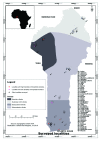Mapping the distribution of Anopheles funestus across Benin highlights a sharp contrast of susceptibility to insecticides and infection rate to Plasmodium between southern and northern populations
- PMID: 28191507
- PMCID: PMC5300096
- DOI: 10.12688/wellcomeopenres.10213.2
Mapping the distribution of Anopheles funestus across Benin highlights a sharp contrast of susceptibility to insecticides and infection rate to Plasmodium between southern and northern populations
Abstract
Background. Malaria remains an important public health issue in Benin, with Anopheles gambiae s.l. and Anopheles funestus s.s being the predominant vectors. This study was designed to generate information on An. funestus distribution, molecular speciation, Plasmodium infection rate and insecticide susceptibility status across Benin. Methods. Mosquito samples were collected from December 2014 to January 2016 in 46 localities in Benin. These samples were mapped and An. funestus collected were speciated to the molecular level. Plasmodium infection rate was determined using a Taqman assay and susceptibility to insecticides was assessed using the WHO guidelines. The genotyping of the L119F- Gste2 mutation was also carried out. Results. An. funestus was found in 8 out of the 46 localities surveyed with a high presence in Tanongou (wet Sudanese ecological zone), Kpome, Doukonta and Pahou (sub-equatorial ecological zone). Molecular identifications revealed that only An. funestuss.s was present in southern Benin, whereas in Tanongou (northern Benin) An. funestus s.s. and An. leesoni were found in sympatry at proportions of 77.7% and 22.3% respectively. Plasmodium infection rate of An. funestus was higher in southern Benin at a range of 13 to 18% compared to 5.6% recorded in Tanongou. High DDT (8±0.5%) and permethrin (11±0.5%) resistance were observed in Doukonta, Kpome and Pahou, contrasting with relatively low resistance profiles: mortality-DDT=90±3.18% and mortality-permethrin=100% in Tanongou. Genotyping analysis revealed high frequency of the resistant 119F allele in the South (Kpome and Doukonta) compared to the North (Tanongou). Discussion and Conclusion. The high presence of An. funestus in the South compared to the North could be due to favorable environmental and climatic conditions found in both regions. A significant Plasmodium infection rate was recorded across the country. A high resistance profile was recorded in the southern Benin; this raises the need for further investigations on resistance selection factors.
Keywords: Anopheles funestus; Benin; Plasmodium infection; South-North; distribution; insecticide resistance.
Conflict of interest statement
No competing interests were disclosed.
Figures




Similar articles
-
Multiple insecticide resistance in an infected population of the malaria vector Anopheles funestus in Benin.Parasit Vectors. 2016 Aug 17;9:453. doi: 10.1186/s13071-016-1723-y. Parasit Vectors. 2016. PMID: 27531125 Free PMC article.
-
Investigation of DDT resistance mechanisms in Anopheles funestus populations from northern and southern Benin reveals a key role of the GSTe2 gene.Malar J. 2020 Dec 17;19(1):456. doi: 10.1186/s12936-020-03503-2. Malar J. 2020. PMID: 33334345 Free PMC article.
-
Evidence of a multiple insecticide resistance in the malaria vector Anopheles funestus in South West Nigeria.Malar J. 2016 Nov 22;15(1):565. doi: 10.1186/s12936-016-1615-9. Malar J. 2016. PMID: 27876039 Free PMC article.
-
Vectorial competence, insecticide resistance in Anopheles funestus and operational implications for malaria vector control strategies in Benin Republic.Malar J. 2023 Dec 21;22(1):385. doi: 10.1186/s12936-023-04815-9. Malar J. 2023. PMID: 38129880 Free PMC article. Review.
-
Review of the evolution of insecticide resistance in main malaria vectors in Cameroon from 1990 to 2017.Parasit Vectors. 2017 Oct 10;10(1):472. doi: 10.1186/s13071-017-2417-9. Parasit Vectors. 2017. PMID: 29017590 Free PMC article. Review.
Cited by
-
Malaria prevalence and transmission in the Zakpota sub-district of central Benin: baseline characteristics for a community randomised trial of a new insecticide for indoor residual spraying.Parasit Vectors. 2024 Jul 13;17(1):303. doi: 10.1186/s13071-024-06342-1. Parasit Vectors. 2024. PMID: 38997729 Free PMC article. Clinical Trial.
-
Susceptibility Profiles of Helicoverpa armigera (Hübner) (Lepidoptera: Noctuidae) to Deltamethrin Reveal a Contrast between the Northern and the Southern Benin.Int J Environ Res Public Health. 2019 May 28;16(11):1882. doi: 10.3390/ijerph16111882. Int J Environ Res Public Health. 2019. PMID: 31142024 Free PMC article.
-
Fitness Costs of the Glutathione S-Transferase Epsilon 2 (L119F-GSTe2) Mediated Metabolic Resistance to Insecticides in the Major African Malaria Vector Anopheles Funestus.Genes (Basel). 2018 Dec 19;9(12):645. doi: 10.3390/genes9120645. Genes (Basel). 2018. PMID: 30572680 Free PMC article.
-
First report of the presence of L1014S Knockdown-resistance mutation in Anopheles gambiae s.s and Anopheles coluzzii from Togo, West Africa.Wellcome Open Res. 2018 Mar 19;3:30. doi: 10.12688/wellcomeopenres.13888.1. eCollection 2018. Wellcome Open Res. 2018. PMID: 29707654 Free PMC article.
-
Spatial distribution and geospatial modeling of potential spread of secondary malaria vectors species in Nigeria using recently collected empirical data.PLoS One. 2025 Apr 21;20(4):e0320531. doi: 10.1371/journal.pone.0320531. eCollection 2025. PLoS One. 2025. PMID: 40258055 Free PMC article.
References
-
- WHO: World malaria report. Geneva, Switzerland, World Health Organization;2016. Reference Source
-
- Ossè R, Gnanguenon V, Sèzonlin M, et al. : Relationship between the presence of kdr and Ace-1 mutations and the infection with Plasmodium falciparum in Anopheles gambiae s.s. in Benin. J Parasitol Vector Biol. 2012;4(3):31–9. Reference Source
-
- WHO: A new malaria framework for Africa. Geneva, Switzerland, World Health Organization;2016. Reference Source
-
- Aïkpon R, Ossè R, Govoetchan R, et al. : Entomological baseline data on malaria transmission and susceptibility of Anopheles gambiae to insecticides in preparation for Indoor Residual Spraying (IRS) in Atacora, (Benin). J Parasitol Vector Biol. 2013;5(7):102–11. Reference Source
Grants and funding
LinkOut - more resources
Full Text Sources
Other Literature Sources
Miscellaneous

